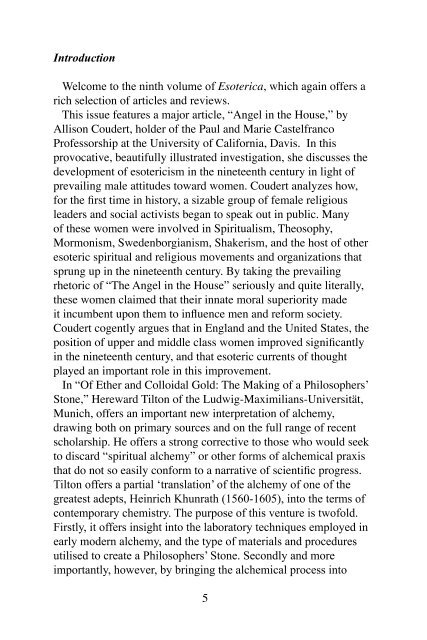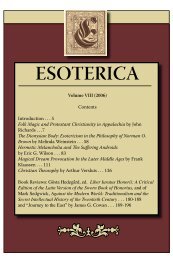Of Ether and Colloidal Gold - Esoterica - Michigan State University
Of Ether and Colloidal Gold - Esoterica - Michigan State University
Of Ether and Colloidal Gold - Esoterica - Michigan State University
Create successful ePaper yourself
Turn your PDF publications into a flip-book with our unique Google optimized e-Paper software.
Introduction<br />
Welcome to the ninth volume of <strong>Esoterica</strong>, which again offers a<br />
rich selection of articles <strong>and</strong> reviews.<br />
This issue features a major article, “Angel in the House,” by<br />
Allison Coudert, holder of the Paul <strong>and</strong> Marie Castelfranco<br />
Professorship at the <strong>University</strong> of California, Davis. In this<br />
provocative, beautifully illustrated investigation, she discusses the<br />
development of esotericism in the nineteenth century in light of<br />
prevailing male attitudes toward women. Coudert analyzes how,<br />
for the first time in history, a sizable group of female religious<br />
leaders <strong>and</strong> social activists began to speak out in public. Many<br />
of these women were involved in Spiritualism, Theosophy,<br />
Mormonism, Swedenborgianism, Shakerism, <strong>and</strong> the host of other<br />
esoteric spiritual <strong>and</strong> religious movements <strong>and</strong> organizations that<br />
sprung up in the nineteenth century. By taking the prevailing<br />
rhetoric of “The Angel in the House” seriously <strong>and</strong> quite literally,<br />
these women claimed that their innate moral superiority made<br />
it incumbent upon them to influence men <strong>and</strong> reform society.<br />
Coudert cogently argues that in Engl<strong>and</strong> <strong>and</strong> the United <strong>State</strong>s, the<br />
position of upper <strong>and</strong> middle class women improved significantly<br />
in the nineteenth century, <strong>and</strong> that esoteric currents of thought<br />
played an important role in this improvement.<br />
In “<strong>Of</strong> <strong>Ether</strong> <strong>and</strong> <strong>Colloidal</strong> <strong>Gold</strong>: The Making of a Philosophers’<br />
Stone,” Hereward Tilton of the Ludwig-Maximilians-Universität,<br />
Munich, offers an important new interpretation of alchemy,<br />
drawing both on primary sources <strong>and</strong> on the full range of recent<br />
scholarship. He offers a strong corrective to those who would seek<br />
to discard “spiritual alchemy” or other forms of alchemical praxis<br />
that do not so easily conform to a narrative of scientific progress.<br />
Tilton offers a partial ‘translation’ of the alchemy of one of the<br />
greatest adepts, Heinrich Khunrath (1560-1605), into the terms of<br />
contemporary chemistry. The purpose of this venture is twofold.<br />
Firstly, it offers insight into the laboratory techniques employed in<br />
early modern alchemy, <strong>and</strong> the type of materials <strong>and</strong> procedures<br />
utilised to create a Philosophers’ Stone. Secondly <strong>and</strong> more<br />
importantly, however, by bringing the alchemical process into<br />
5



